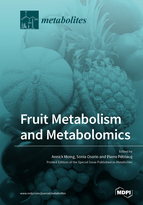Fruit Metabolism and Metabolomics
A special issue of Metabolites (ISSN 2218-1989). This special issue belongs to the section "Plant Metabolism".
Deadline for manuscript submissions: closed (15 February 2020) | Viewed by 64533
Special Issue Editors
Interests: plant metabolomics; fruit metabolism; biomarker metabolites; proton NMR metabolomic profiling; metabolomic data combination
Interests: fruit quality; post-harvest; biotechnology; genomics; metabolomics
Interests: plant biochemistry; redox metabolism; mass spectrometry
Special Issues, Collections and Topics in MDPI journals
Special Issue Information
Dear Colleagues,
Fruit development and ripening are complex and highly coordinated developmental processes that yields flavorful tissues for organisms that consume and disperse the associated seeds. Fruits are economically important and crucial for human nutrition and health due to their content in sugars, organic acids, pigments, volatiles and nutraceutical compounds.
In recent years, there have been dramatic improvements in the knowledge of different aspects of fruit metabolism. Specifically, high-throughput metabolomics technologies have provided the quantitation of metabolite levels across various biological processes allowing the identification of the genes underpinning fruit development and ripening. A collection of papers is required to review the current understanding of temperate and tropical fruit metabolism using metabolomics for basic research or practical applications.
This Special Issue will include, but not be limited to, articles and reviews about different aspects of fruit metabolism, including primary and specialized metabolisms, and postharvest. The effect of genotype, biotic or abiotic environment and their interaction on metabolomic profiles and metabolism are within the scope of the present topic. Studies of fruit lipidomics or a combination of genomics or other omics with metabolomics are also welcomed.
Dr. Annick Moing
Dr. Sonia Osorio
Dr. Pierre Pétriacq
Guest Editors
Manuscript Submission Information
Manuscripts should be submitted online at www.mdpi.com by registering and logging in to this website. Once you are registered, click here to go to the submission form. Manuscripts can be submitted until the deadline. All submissions that pass pre-check are peer-reviewed. Accepted papers will be published continuously in the journal (as soon as accepted) and will be listed together on the special issue website. Research articles, review articles as well as short communications are invited. For planned papers, a title and short abstract (about 100 words) can be sent to the Editorial Office for announcement on this website.
Submitted manuscripts should not have been published previously, nor be under consideration for publication elsewhere (except conference proceedings papers). All manuscripts are thoroughly refereed through a single-blind peer-review process. A guide for authors and other relevant information for submission of manuscripts is available on the Instructions for Authors page. Metabolites is an international peer-reviewed open access monthly journal published by MDPI.
Please visit the Instructions for Authors page before submitting a manuscript. The Article Processing Charge (APC) for publication in this open access journal is 2700 CHF (Swiss Francs). Submitted papers should be well formatted and use good English. Authors may use MDPI's English editing service prior to publication or during author revisions.
Keywords
- Fruit metabolomics
- Developmental metabolomics
- Spatial metabolomics
- Lipidomics
- Fruit metabolomic profiling
- Central metabolism
- Specialized metabolism
- Mass spectrometry
- Nuclear magnetic resonance spectroscopy
- Omics data integration









